GDF5
-
Official Full Name
growth differentiation factor 5
-
Overview
The protein encoded by this gene is a member of the bone morphogenetic protein (BMP) family and the TGF-beta superfamily. This group of proteins is characterized by a polybasic proteolytic processing site which is cleaved to produce a mature protein containing seven conserved cysteine residues. The members of this family are regulators of cell growth and differentiation in both embryonic and adult tissues. Mutations in this gene are associated with acromesomelic dysplasia, Hunter-Thompson type; brachydactyly, type C; and chondrodysplasia, Grebe type. These associations confirm that the gene product plays a role in skeletal development. -
Synonyms
GDF5; growth differentiation factor 5; growth/differentiation factor 5; BMP14; cartilage derived morphogenetic protein 1; CDMP1; GDF-5; CDMP-1; radotermin; cartilage-derived morphogenetic protein-1; OS5; LAP4; SYNS2;
- Recombinant Proteins
- Cell & Tissue Lysates
- Protein Pre-coupled Magnetic Beads
- Chicken
- Human
- Mouse
- Rat
- E.coli
- HEK293
- Mammalian Cell
- Wheat Germ
- C
- His
- GST
- His (Fc)
- Avi
- His(C
- ter)
- N/A
- Background
- Quality Guarantee
- Case Study
- Involved Pathway
- Protein Function
- Interacting Protein
- Other Resource
What is gdf5 protein?
The GDF5 protein, also known as Growth Differentiation Factor 5, is one of the essential proteins controlling bone and cartilage development in mammals. This article will delve into its discovery, background, gene locus, and protein structure, shedding light on its crucial functions, related signal pathway, diseases, as well as practical applications.
Discovered initially in the 1990s, GDF5 emerged as one of the key proteins responsible for controlling the growth and development of bones and cartilage in the body. It's a part of the Transforming Growth Factor-Beta (TGF-β) superfamily, a group of proteins that regulate various aspects of cell growth, differentiation, and development.
The gene for the GDF5 protein is located on chromosome 20 at the locus 20q11.22. It spans over 60 kb and contains two exons separated by a large intronic sequence. The protein structure of GDF5 consists of a signal peptide, a pro-region, and a mature region. The mature region is responsible for the functionality of the protein and is highly conserved among species. The pro-region assists in folding the mature region into its functional three-dimensional structure.
What are the functions of GDF5 protein?
GDF5 plays a pivotal role in the development, maintenance, and repair of the skeletal system. During embryonic development, it signals the formation of bones and joints, contributing to the pattern of limb skeletal elements. GDF5 protein is also essential in the maintenance of healthy cartilage and bone tissue in adults, facilitating tissue repair in case of injury.
Moreover, GDF5 is involved in the formation of other tissues such as the middle ear bones and certain parts of the nervous system. Recent research indicates that GDF5 also plays a function in developing specialized structures in the intestine, with potential implications for diseases like colorectal cancer.
GDF5 protein related signal pathway
The signaling pathway of the GDF5 protein is primarily linked with the Bone Morphogenetic Protein (BMP) receptors. Upon binding to the specific type I and type II BMP receptors, GDF5 triggers the SMAD pathway, a series of biochemical events that lead to the activation of certain genes involved in cell growth and differentiation.
GDF5 protein related diseases
Mutations in the GDF5 gene can cause several types of disorders, all characterized by abnormal skeletal development. These include various forms of brachydactyly, a condition where individuals have unusually short fingers or toes. More severe mutations can result in conditions like acromesomelic chondrodysplasia, where long bones of the arms and legs are abnormally short.
Alterations in GDF5 are also linked with osteoarthritis, a common degenerative joint disease often associated with aging. Several studies found certain variations in the GDF5 gene region increase the risk of developing knee and hip osteoarthritis.
- Brachydactyly Type C: Short middle bones of the fingers and toes. Caused by dominant/recessive mutations in GDF5.
- Du Pan Syndrome: Family of disorders involving very short fingers and large joints. Autosomal dominant GDF5 mutations cause some forms.
- Osteoarthritis: Polymorphisms in GDF5 are linked to increased risk and earlier onset of osteoarthritis, likely due to impaired cartilage maintenance.
- Acromesomelic Dysplasia, type Grebe: Rare skeletal disorder with very short limb bones. Autosomal recessive GDF5 mutations involved.
- Bone regeneration: Delivery of recombinant BMP2/scaffolds to promote healing of fractures, spinal fusions via its osteogenic effects. Used in some medical devices.
- Cartilage repair: Engineering cartilage tissues by culturingBMP2 with stem cells/chondrocytes to treat osteochondral defects, osteoarthritis.
- Spinal fusion: BMP2 is commonly used clinically to stimulate bone growth in complex spinal surgeries requiring fusion.
Owing to its crucial role in tissue maintenance and repair, GDF5 protein has significant potential in the field of regenerative medicine. In potential future therapies, biomedical researchers foresee the application of GDF5 protein to stimulate the repair of cartilage in patients with osteoarthritis, potentially slowing or even halting the progression of the disease.
- Bone regeneration: Delivery of recombinant BMP2/scaffolds to promote healing of fractures, spinal fusions via its osteogenic effects. Used in some medical devices.
- Cartilage repair: Engineering cartilage tissues by culturingBMP2 with stem cells/chondrocytes to treat osteochondral defects, osteoarthritis.
- Spinal fusion: BMP2 is commonly used clinically to stimulate bone growth in complex spinal surgeries requiring fusion.
High Purity
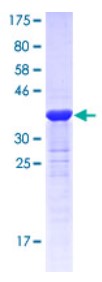
Fig1. SDS-PAGE (Cat. No.: GDF5-4827H)
Case 1:Murakami T, et al. HOXA10 promotes Gdf5 expression in articular chondrocytes. Sci Rep. 2023 Dec 20;13(1):22778. doi: 10.1038/s41598-023-50318-7. PMID: 38123662; PMCID: PMC10733362.
Growth differentiation factor 5 (GDF5), a BMP family member, is highly expressed in the surface layer of articular cartilage. The GDF5 gene is a key risk locus for osteoarthritis and Gdf5-deficient mice show abnormal joint development, indicating that GDF5 is essential in joint development and homeostasis. In this study, the researchers aimed to identify transcription factors involved in Gdf5 expression by performing two-step screening.
Their results indicate the important role played by HOXA10 in Gdf5 regulation and the usefulness of Gdf5-HiBiT KI mice for monitoring Gdf5 expression.
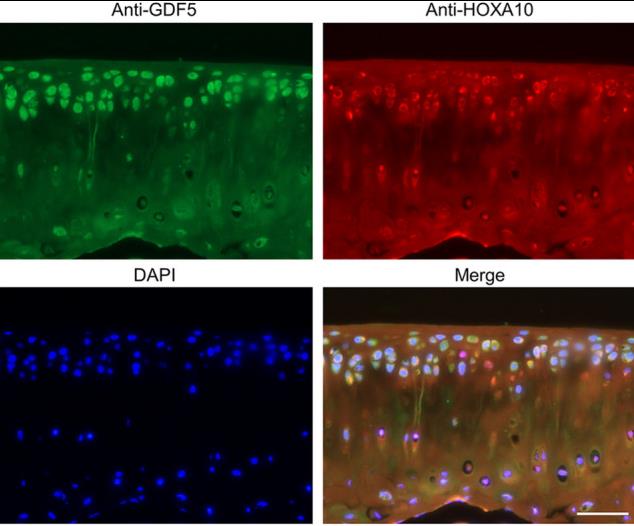
Fig1. Immunofluorescent analysis of HOXA10 and GDF5 in articular cartilage. Tibial sections from 3-month-old mice were subjected to co-immunostaining with anti-HOXA10 and anti-GDF5 antibodies. DAPI indicates nucleus.
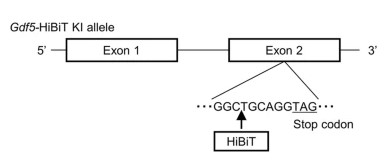
Fig2. Schematic diagram of Gdf5-HiBiT allele. The stop codon of Gdf5 and the knocked-in position of HiBiT tag are indicated.
Case 2: Gipson GR, et al. Formation and characterization of BMP2/GDF5 and BMP4/GDF5 heterodimers. BMC Biol. 2023 Feb 1;21(1):16. doi: 10.1186/s12915-023-01522-4. PMID: 36726183; PMCID: PMC9893541.
In this study, researchers have determined that mature GDF5 can be combined with mature BMP2 or BMP4 to form BMP2/GDF5 and BMP4/GDF5 heterodimer. Intriguingly, this combination of a BMP2 or BMP4 monomer, which exhibit high affinity to heparan sulfate characteristic to the BMP class, with a GDF5 monomer with low heparan sulfate affinity produces a heterodimer with an intermediate affinity.
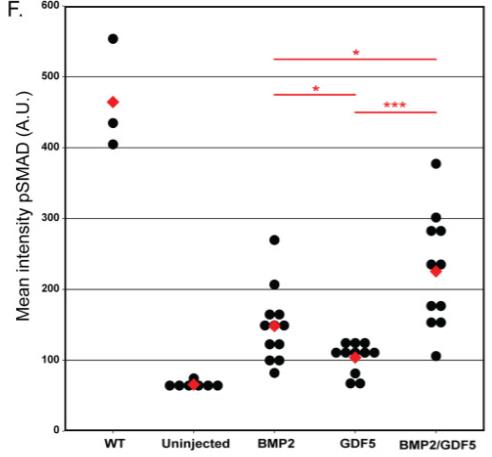
Fig1.BMP2/GDF5 heterodimer signals more effectively than BMP2 or GDF5 homodimers in developing Zebrafish blastula.Quantification of the nuclear pSMAD5 fluorescence in embryos was done by calculating the average intensity of the brightest 75% of nuclei minus the average intensity of the dimmest 25% (assumed background). Each black dot is a single embryo.
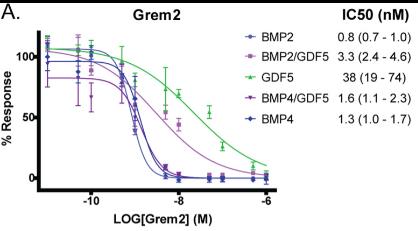
Fig2. Comparison of inhibitory activity of protein antagonists for heterodimers and homodimers. Inhibition of BMP signaling induced by BMP2 (light blue), BMP4 (dark blue), GDF5 (green), BMP2/GDF5 (light purple), and BMP4/GDF5 (dark purple) by Gremlin 2 (A), Noggin
GDF5 involved in several pathways and played different roles in them. We selected most pathways GDF5 participated on our site, such as Cytokine-cytokine receptor interaction, TGF-beta signaling pathway, Hippo signaling pathway, which may be useful for your reference. Also, other proteins which involved in the same pathway with GDF5 were listed below. Creative BioMart supplied nearly all the proteins listed, you can search them on our site.
| Pathway Name | Pathway Related Protein |
|---|---|
| Cytokine-cytokine receptor interaction | CXCR4B;FLT4;TNFRSF14;INHBE;IFNA17;CXCL2;LIFRA;LTB;CXCL12B |
| TGF-beta signaling pathway | BMP5;MYCB;TGFB1;RBX1;SMAD7;BMP8B;RHOAB;ACVR1BA;BMP2B |
| Hippo signaling pathway | LLGL1;DVL3;BMP8A;SERPINE1;BBC3;TGFB3;TEAD4;WNT9B;FGF1 |
GDF5 has several biochemical functions, for example, BMP binding, cytokine activity, growth factor activity. Some of the functions are cooperated with other proteins, some of the functions could acted by GDF5 itself. We selected most functions GDF5 had, and list some proteins which have the same functions with GDF5. You can find most of the proteins on our site.
| Function | Related Protein |
|---|---|
| BMP binding | GDF5;GREM2;BMPR2;HFE2;TCAP;GREM1;CER1;NBL1 |
| cytokine activity | IL3;IFNA1;TNFSF13B;CMTM2;NODAL;CLCF1;TGFB2;OSM;GREM2 |
| growth factor activity | LEFTY1;LFT2;LACRT;FGF18;FGF17;FGF1B;LIF;GDF2;TDGF1 |
| identical protein binding | SNX33;TNN;MYBPC3;SETX;PLN;ZNF212;DYNLRB1;SNCAIP;SOD2 |
| protein binding | OBFC1;SPRTN;ZNF576;GPR3;DLG4;FAM125B;TNNT1;KRT81;ZNF490 |
| transforming growth factor beta receptor binding | LFT2;SMURF2;GDF6B;GDF7;INHBAA;BMP8A;FKBP1A;GDF9;NDR1 |
GDF5 has direct interactions with proteins and molecules. Those interactions were detected by several methods such as yeast two hybrid, co-IP, pull-down and so on. We selected proteins and molecules interacted with GDF5 here. Most of them are supplied by our site. Hope this information will be useful for your research of GDF5.
BMPR1B; BMPR1A; NOG; BMPR2
Gene Family
Research Area
Related articles
- Q&As
- Reviews
Q&As (5)
Ask a questionGDF5 has been found to stimulate the proliferation and differentiation of chondrocytes, the cells responsible for cartilage formation and maintenance.
Preclinical studies have demonstrated GDF5's ability to promote bone and cartilage regeneration in animal models, providing a foundation for further clinical exploration.
GDF5's specificity for bone and cartilage development distinguishes it from other growth factors, making it a targeted option for orthopedic interventions.
Some studies suggest that combining GDF5 with other growth factors or therapeutic approaches may result in synergistic effects, improving overall outcomes.
While its primary focus is on musculoskeletal conditions, GDF5's role in cellular differentiation opens avenues for exploring its applications in broader regenerative medicine contexts.
Customer Reviews (3)
Write a reviewTheir dedicated team of experts is prompt, knowledgeable, and readily available to tackle any hurdles or concerns I may encounter.
Used in protein electron microscopy structure analysis.Great.
By harnessing the power of the GDF5 protein, I can harness its outstanding quality and tap into its potential to obtain dependable and meaningful findings.
Ask a Question for All GDF5 Products
Required fields are marked with *
My Review for All GDF5 Products
Required fields are marked with *


